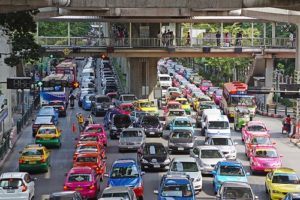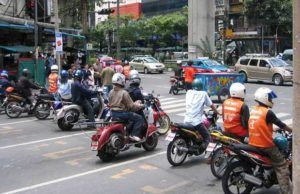Skootar: Transforming the Messenger Service in Bangkok

How one company is digitally transforming the Bangkok courier system.
Bangkok has a sprawling metro system, consisting of a network of skytrains, subways, river ferries, and canals. However, for years, the Bangkok metropolitan area has wrestled with traffic congestion. A recent study placed Bangkok second on the list of most congested cities in the world. During morning rush hour, Bangkok’s traffic moves 85% slower on average compared with a clear road situation and further slows to a “snail-like” 114% in the evening, meaning that journey times more than double during commutes [1]. Unfortunately, the traffic situation is only expected to worsen, especially as Thailand’s middle class continues to grow [2].
Enter, Kamolprudh Jumbala, CEO of Skootar. Kamolprudh, along with one of his co-founders, had operated a few businesses before founding Skootar. One of the biggest struggles they had encountered in every business was finding a reliable messenger who could run business errands around Bangkok in a reliable and timely fashion. Errands ranged from sending invoices to clients, collecting checks from consumers, and delivering other important documents and packages. A lot of the time, they found themselves navigating through the Bangkok traffic in their mid-sized sedans, spending hours in traffic – hours that they could have utilized much more productively otherwise. Realizing that this problem was something a majority of the small- and medium-sized enterprise (“SME”) market faced, coupled with the recent proliferation of that market, Kamolprudh and his co-founders came up with an idea to build a platform to help solve these issues and allow businesses to operate more efficiently and reliably [3].
Skootar. Skootar is a digital platform that allows customers to place motorcycle delivery orders in the Bangkok metropolitan area via its website and smartphone application. In Bangkok, motorcycle taxis are a licensed form of transport, and one of the fastest and most popular ways to get around town. If you have ever been to Bangkok, you cannot have missed the sight of motorcycle taxi drivers in bright orange vests whizzing between cars and in and out of seemingly impossible to maneuver traffic gridlocks.
The application and website serve as a marketplace that connect SMEs and home users with motorcycle messengers, allowing customers to easily place an order around the clock, 24 hours a day, seven days a week. The Skootar platform will then match the order with the closest and most reliable drivers within a couple of minutes. Drivers go through a rigorous screening and training process, and peer ratings keep the system fair and transparent. Users are also able to track the job status and driver location during the process and payments are easily made online or through the application.
Skootar’s business model leads to genuine value creation and efficiencies. SKOOTAR’s goal is “to provide motorcycle delivery service that gets more convenient, reliable, and cost efficient every day” [3]. Utilizing motorbikes to navigate through traffic while providing access to safe, reliable drivers is an ingenious way of turning a troublesome process into a more efficient one that can be completed within seconds. The delivery process is enhanced by calculating and combining similar routes to optimize the time and cost, and as a result, SMEs are able to operate in a more effective and cost-efficient manner while not having to deal with trust issues surrounding time, price, and driver behavior. Thousands of businesses and individuals are utilizing Skootar for same day pickup and delivery of documents and parcels [4], [5].
Skootar is successfully displacing the archaic messenger systems that have pervaded Bangkok, winning business from competitors such as Classic Express Service (“CES”) Logistics. The Company is in a strong position to capitalize on a largely underpenetrated market. While future threats include increased competition, Skootar has unparalleled first-mover advantages and can also expand its service to all niches of the on-demand market, including food delivery and transportation.
Word Count: 645
Text Citations:
[1] Ho, Victoria. “Bangkok Is the Second-most Congested City in the World.” Mashable. Accessed November 18, 2016. http://mashable.com/2016/03/22/bangkok-traffic-jams/.
[2] “Bangkok.” CNNMoney. Accessed November 18, 2016. http://money.cnn.com/gallery/news/2016/03/21/worst-traffic-cities/index.html.
[3] SEAS100. “Skootar Co., Ltd. | The South East Asia Startups 100.” The South East Asia Startups 100. Accessed November 18, 2016. http://seas100.com/en/seas-en/skootar-co-ltd-2/.
[4] “SKOOTAR | LinkedIn.” Accessed November 18, 2016. https://www.linkedin.com/company/skootar.
[5] Pardon Our Interruption. Accessed November 18, 2016. https://www.crunchbase.com/organization/skootar.
Picture Citations:
[1] “Tech in Asia – Connecting Asia’s Startup Ecosystem.” Tech in Asia – Connecting Asia’s Startup Ecosystem. Accessed November 18, 2016. https://www.techinasia.com/dtac-thai-startups-at-tia-sg-2016.
[2] “BRT for Free in Bangkok | TheCityFix.” TheCityFix. Accessed November 18, 2016. http://thecityfix.com/blog/brt-for-free-in-bangkok/.
[3] “Motorcycle Taxis in Thailand – My-Thai.org.” My-Thai.org. Accessed November 18, 2016. http://my-thai.org/motorcycle-taxis-thailand/.
[4] “เรียกแมสเซ็นเจอร์ออนไลน์.” SKOOTAR. Accessed November 18, 2016. https://www.skootar.com/.







Fascinating article. Traffic congestion is a problem many developing (any some developed) nations cannot seem to get ahead of. I recently spent time in the Philippians and was amazed how much more efficient motorcycle taxis are over standard vehicles. A relaxed attitude toward traffic laws is certainly required to take full advantage of the maneuverability of two-wheeled vehicles, but I expect that the inherently low speeds of a traffic jam and the skills of professional drivers go a long way toward preventing serious accidents. I guess it was only a matter of time before smartphones and scooters joined forces. Interestingly, I have yet to come across an Uber-like motorcycle/scooter taxi service in my travels.
This is like Uber on motorcycles transporting products instead of people– very interesting! You mentioned that “Skootar is successfully displacing the archaic messenger systems that have pervaded Bangkok,” which leads me to believe that the are doing pretty well (is this correct?). If so, do you know how they were able to get people to trust the system? I suspect that people were probably initially worried about the idea of having a stranger pick up/ deliver something value– what approaches did they take to effectively launch the product?
Uber actually launched a motorbike service this year in Bangkok (http://www.theverge.com/2016/2/24/11104394/uber-motorcycle-service-bangkok-ubermoto). If Skootar was thinking of moving from SMEs into the direct consumer market, they’ll have some competition.
This is pretty interesting and although a good solution to deal with congestion, part of me thinks its not enough. As nate mentioned, congestion is a widespread problem for most large cities in developing countries, what is Skootar’s relationship with the government like and what is the government doing to alleviate these issues? Do you thin its in Skootar’s best interest to lobby for better infrastructure/mass transit systems? Part of me thinks that even if this is a better solution than using a sedan to deliver, the traffic will continue to worsen and even the scooters won’t be enough to alleviate the issue…
I have a close friend who helped manage operations for Lazada’s warehouse in Bangkok. Lazada often used motorcycles to deliver orders to customers, but came across several challenges. One of the main challenges was the safety and integrity of motorcycle drivers when they delivered products for cash on delivery. Driving around with large amounts of cash can (1) put the driver at risk of robbery or (2) encourage the driver to just drive off with the cash rather than return to the warehouse. How is Skootar addressing some of these issues?
I have visited Bangkok for a couple of times and was pretty struck by local traffic jam, especially in peak hours. I would normally choose tuk tuks as they are always faster than taxi on busy streets. Bangkok is a city full of motorcycles, so it’s pretty straightforward to imagine people could leverage them to deliver packages. I would be very curious about qualifications of motorcycle drivers. Especially what kinds of measures does Skooter adopt to ensure package safety. I would also be interested to know if Skooter could really make money through this business. As far as I know, this kind of business is hugely subsidized by VCs during business expansion period.
Great post, Madhur! I’m curious: what is Skootar doing to insulate itself from its likely largest competitor, Uber? In large cities like New York, Uber is the leading company in last-mile bicycle delivery. What kinds of competitive advantages can Skootar build using digital technology to help insulate itself from this competition? One idea that comes to mind is for Skootar to build electronic systems which link into their customers databases / electronic systems. This would even further streamline the process for customers as well as build additional stickiness into the relationship between Skootar and the customer.
Interesting post! I, myself, have been a victim of the traffic problems in Bangkok, having got stuck for hours on end, when visiting the city as a tourist. Kamolprudh certainly seems to have come up with an innovative solution – an ‘Uberization’ of a variety of services – to help clients solve this problem. As you mentioned, Skootar benefits from a first mover advantage. It would be interesting to know what the company plans to do to sustain this advantage. Is there any particular aspect of their customer service – trust, reliability, speed etc – which builds customer loyalty and can be leveraged to acquire new customers? Seeing the traction Skootar has received, many competitors may enter the same space. What do you think is Skootar’s key differentiator for its customers? As we often discuss in class, what is its edge?